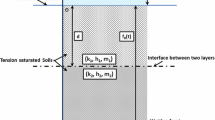Abstract
In water spreading and underground hydrology, one should beware of pitfalls. This is illustrated by several examples of vertical downflow and upflow. Drainage by overcharging: When a fine-grained soil overlies a coarse-grained soil, a certain amount of water can be suspended in the interzone. Adding water may cause excessive drainage. Cavitation in soils: When water flows from an upper less pervious layer to a more pervious layer, the pressure head in the interzone may become negative, the gases dissolved are released in the form of bubbles which render the soil temporarily impervious. At the initial instant of seepage of water from a pond into a dry soil, inertial forces and kinetic energy cannot be neglected. At the interface of two anisotropic media, the angle of refraction of a streamline depends on the tangential hydraulic conductivity only, whereas that of a gradient line depends on the normal component only. Impossibility of steady-state evaporation from a deep water table: It is shown that the water concentration may become negative, which is physically impossible. Two modes of downflow: In insaturated downflow there exists a critical water concentration c such that the corresponding hydraulic conductivity K(c) is equal to the descending specific flux. The moisture distribution is radically different in the subcritical and supercritical zones.
Similar content being viewed by others
References
Bodman, G. B. and Colman, E., 1943, Moisture and energy conditions during downward entry of water into soils, Proc. Soil Sci. Soc. Am. 8, 116–122.
Irmay, S., 1947, Sur le mouvement des eaux dans le sol, Revue Univ. des Mines, Liège 3, 129–139.
Irmay, S., 1951, On the motion of capillary moisture in soils, Sci. Publ. Hebrew Inst. Technol. Haifa 4, 43–90 (in Hebrew, English abstract).
Irmay, S., 1953, Saturated steady flow in nonhomogeneous soils and its applications to earth embankments, wells, drains, Proc. 3rd Int. Conf. on Soil Mech. and Found. Eng., Zürich, Vol. 2, 259–263.
Irmay, S., 1954, On the hydraulic conductivity of unsaturated soils, Trans. Amer. Geophys. Union 35, 463–467.
Irmay, S., 1956, Extension of Darcy law to unsaturated flow through porous media, Int. Ass. Sci. Hydrol. IUGG, Symposia Darcy, Dijon, Pub. No. 41, 57–60.
Irmay, S., 1961, Unsteady flow through porous materials, Proc. 9th Conf. IAHR, Dubrovnik, 414–427.
Irmay, S., 1964, Refraction d'un écoulement à la frontière séparant deux milieux poreux anisotropes différent, Comptes Rendus, Acad. Sci., Paris 259, 509–511.
Irmay, S., 1966, Solutions of the nonlinear diffusion equation with a gravity term in hydrology, Sympos. Water in the Unsaturated Zone, Unesco, Wageningen, June.
Irmay, S., Bear, J., and Zaslavsky, D., 1968, Physical percolation and seepage, in S. Irmay (ed.), Arid Zone 29, Unesco, Paris, pp. 51–176.
Richards, L. A., Research Vol. 1931, Capillary conduction of liquids through porous medium, Physics 1, 318–333.
Terzaghi, K. von, 1925, Erdbaumechanik auf bodenphysikalischer Grundlage, Deuticke, Leipzig.
Topp, G. C. and Miller, E. E., 1965, Hysteretic conductivity: calculation versus measurement, Agronomy Abst., 1964 ADSA Meeting, and private communication.
Author information
Authors and Affiliations
Rights and permissions
About this article
Cite this article
Irmay, S. On some apparent paradoxes in water spreading, hydrology and seepage. Water Resour Manage 4, 273–281 (1991). https://doi.org/10.1007/BF00430341
Received:
Issue Date:
DOI: https://doi.org/10.1007/BF00430341




